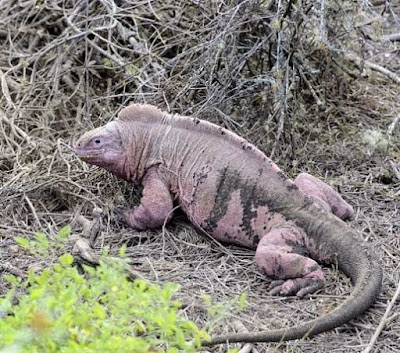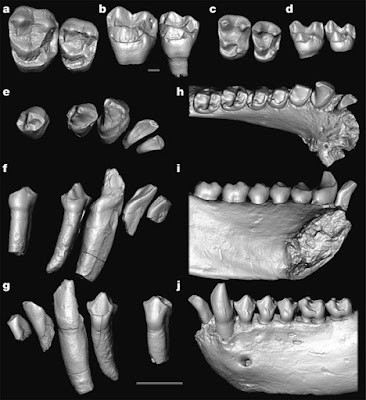[Most Recent Entries] [Calendar View]
Saturday, April 23rd, 2016
| Time | Event | ||||||
| 2:38a | [Herpetology • 2009] Conolophus marthae • A New Species of Land Iguana (Squamata, Iguanidae) from the Galápagos Archipelago
Abstract Conolophus marthae sp. nov., a new species endemic to Volcan Wolf of northern Isla Isabela of the Galápagos archipelago, is described. The new species is morphologically, behaviorally, and genetically distinguished from the other two congeneric species C. subcristatus and C. pallidus. Besides the taxonomic implications, C. marthae sp. nov. is extremely important as it is the only evidence of deep divergence within the Galápagos land iguana lineage. Key words: Galápagos pink land iguana, Conolophus, Iguanidae, Squamata, Galápagos Islands, Galápagos National Park, lizards, endemism
Etymology. The new species is named in memory of Martha Rebecca Gentile, second daughter of the first author. Martha prematurely left this world. She was born dead, as consequence of a medical doctor’s negligence, on August 20th 2003. Distribution. Thus far, this species is known to occur only on Volcan Wolf (Fig. 1), the northernmost volcano of Isla Isabela (Galápagos National Park, Ecuador). Gentile, Gabriele and Snell, Howard L. 2009. Conolophus marthae sp.nov. (Squamata, Iguanidae), A New Species of Land Iguana from the Galápagos Archipelago. Zootaxa. 2201: 1–10. Volcano erupts in Galapagos Islands; only known home to recently-described pink #iguanas http://reut.rs/1HJaWdx @SheddResearch Galápagos Islands volcanic eruption could threaten pink iguana species http://gu.com/p/497qz | ||||||
| 8:42a | [PaleoMammalogy • 2016] Panamacebus transitus • First North American Fossil Monkey and early Miocene Tropical Biotic Interchange
Abstract New World monkeys (platyrrhines) are a diverse part of modern tropical ecosystems in North and South America, yet their early evolutionary history in the tropics is largely unknown. Molecular divergence estimates suggest that primates arrived in tropical Central America, the southern-most extent of the North American landmass, with several dispersals from South America starting with the emergence of the Isthmus of Panama 3-4 million years ago (Ma). The complete absence of primate fossils from Central America has, however, limited our understanding of their history in the New World. Here we present the first description of a fossil monkey recovered from the North American landmass, the oldest known crown platyrrhine, from a precisely dated 20.9-Ma layer in the Las Cascadas Formation in the Panama Canal Basin, Panama. This discovery suggests that family-level diversification of extant New World monkeys occurred in the tropics, with new divergence estimates for Cebidae between 22 and 25 Ma, and provides the oldest fossil evidence for mammalian interchange between South and North America. The timing is consistent with recent tectonic reconstructions of a relatively narrow Central American Seaway in the early Miocene epoch, coincident with over-water dispersals inferred for many other groups of animals and plants. Discovery of an early Miocene primate in Panama provides evidence for a circum-Caribbean tropical distribution of New World monkeys by this time, with ocean barriers not wholly restricting their northward movements, requiring a complex set of ecological factors to explain their absence in well-sampled similarly aged localities at higher latitudes of North America.
Primates Linnaeus, 1758 Anthropoidea Mivart, 1864 Platyrrhini Geoffroy, 1812 Cebidae Bonaparte, 1831 Panamacebus transitus gen. et sp. nov. Etymology. Generic name combines ‘Panama’ with ‘Cebus’, root taxon for Cebidae. Specific name ‘transit’ (Latin, crossing) refers to its implied early Miocene dispersal between South and North America. Holotype. UF 280128, left upper first molar (M1; Fig. 2a, b). Referred material. Left upper second molar (M2; UF 281001; Fig. 2a, b), partial left lower first incisor (I1; UF 280130), right lower second incisor (I2; UF 267048), right lower canine (C1; UF 280131), possibly associated left lower second (P2; UF 280127) and fourth (P4; UF 280129) premolars (Fig. 2e–g). Locality. Lirio Norte (site key YPA-024 in the Florida Museum of Natural History Vertebrate Paleontology Collection), Panama Canal area, Panama, Central America (Extended Data Fig. 1).
Jonathan I. Bloch, Emily D. Woodruff, Aaron R. Wood, Aldo F. Rincon, Arianna R. Harrington, Gary S. Morgan, David A. Foster, Camilo Montes, Carlos A. Jaramillo, Nathan A. Jud, Douglas S. Jones and Bruce J. MacFadden. 2016. First North American Fossil Monkey and early Miocene Tropical Biotic Interchange. Nature. (2016) DOI: 10.1038/nature17415 Seven tiny teeth tell the story of an ancient monkey that made a 100-mile ocean crossing between North and South America into modern-day Panama – the first fossil evidence for the existence of monkeys in North America. http://news.ufl.edu/articles/2016/04/pal |
| << Previous Day |
2016/04/23 [Calendar] |
Next Day >> |







